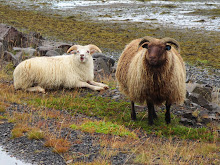Oodles of Penguinos
Have finally arrived in Patagonia after hell journey involving the airline Aerolinas Argentinias whose motto might be: "We Hope to Get you There...Eventually"
Started off the day on our personal tour with a guide, Pedro, who is a former cattle rancher, bankrupted when the Presidentess (as she insists being called) failed to assist farmers in 2008 during an economic agricultural crisis.
We went to the airport in the Welsh town of Trelew where we picked up a Communist from Italy aged about 65 who sounded like Don Corleone and smoked cigars. As we were talking politics with Pedro and he raised the subject of Berlusconi, the woman remarked in her haughty Milanese Italian: "Ha...Berlusconi! I have a photo of him in my toilet which I shit on every morning and never clean, even if it stinks!" much to the howling laughter of Pedro.
Then off to our destination: Tombin which is home to 100,000 pairs of breeding Magellenic Penguins leaving a total population of some 500,000 penguins when you include the chicks.
Patagonia is all desert and you drive by unpaved road through a private sheep estancia to get to the coast. The native lamas run along side the roads. They are captured briefly each year to be sheered for their wool with the assistance of biologists who ensure they don{t drop dead from stress.
Soon we arrive at penguin central. Having spent about an hour staring rapt at a dirty tank in the acquarium in Mar Del Plata containing a few sad penguins, our first sight of wild penguins leaves C, the Milanese woman and I entranced. I of course start madly taking photos of the only penguin we see until Pedro tells me, we will soon see many, many penguins and we don{t have to linger for this one.
Walking along a set trail some 2 kilometers brings us to penguin heaven. They are literally everywhere: thousands and thousands and thousands of penguins standing in front of you, beside, behind you or waddling along the path or towards the beach.
There are so many in the distance I mistake them for a crowd of people walking.
This species of penguin nest in burrows dug by males. The males come here early, prepare the burrows or fight other males for the best burrow. When the females arrive each burrow comes with a man, and the females will choose the best burrow and get the guy that comes along with it.
They will then mate and after 40 days she will lay two eggs. They will then take turns sitting on the egg while the other one waddles out to the ocean to feed.
When the chicks are born, each penguin will take turns caring for the chicks while the other goes out to the ocean swimming almost 500 kilometres to feed for a week and bring back food to regurgitate to feed the young. The very hungry penguin who stayed behind now gets his or her turn to go off to feed.
After a number of months the chicks will be ready to molt their chick feathers and learn to swim. After a few lessons they will be ready to be on their own and off they and all the other penguins go, up to Brazil spending six months at sea never touching land. Then they swim back down to this area to mate and raise chicks again. Often in the same burrow if possible.
Pedro explained that because they have no natural predators on land, they are completely unafraid of us. If it was the sea, it would be a different matter as sharks, seals, petrels and a host of other meal seekers will attack them in the water.
C and I can sit right beside a penguin while he or she stands just enjoying the breeze, the sun or having a nap. Many penguins sleep standing up. The only rules of the park is to stay on the marked trail (native stone soil just marked by big stones) and always give way penguins whenever they walk in front of you.
Most ignore you but some are quite curious.
Luckily I dont{ take slides, otherwise folks at home would be forced to sit through hours of adorable penguin photos until they decided to strangle us.


0 Comments:
Post a Comment
<< Home